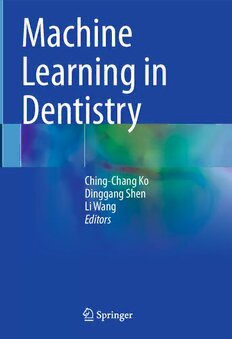Table Of ContentMachine
Learning in
Dentistry
Ching-Chang Ko
Dinggang Shen
Li Wang
Editors
Machine Learning in Dentistry
Ching-Chang Ko • Dinggang Shen (cid:129)
Li Wang
Editors
Machine Learning
in Dentistry
Editors
Ching-ChangKo DinggangShen
OhioStateUniversity SchoolofBiomedicalEngineering
Columbus,OH,USA ShanghaiTechUniversity
Shanghai,Shanghai,China
LiWang
UniversityofNorthCarolina
atChapelHill
ChapelHill,NC,USA
ISBN978-3-030-71880-0 ISBN978-3-030-71881-7 (eBook)
https://doi.org/10.1007/978-3-030-71881-7
©SpringerNatureSwitzerlandAG2021
Thisworkissubjecttocopyright.AllrightsarereservedbythePublisher,whetherthewhole
orpartofthematerialisconcerned,specificallytherightsoftranslation,reprinting,reuseof
illustrations,recitation,broadcasting,reproductiononmicrofilmsorinanyotherphysicalway,
andtransmissionorinformationstorageandretrieval,electronicadaptation,computersoftware,
orbysimilarordissimilarmethodologynowknownorhereafterdeveloped.
Theuseofgeneraldescriptivenames,registerednames,trademarks,servicemarks,etc.inthis
publicationdoes not imply,evenintheabsenceofa specificstatement,thatsuchnamesare
exemptfromtherelevantprotectivelawsandregulationsandthereforefreeforgeneraluse.
Thepublisher,theauthors,andtheeditorsaresafetoassumethattheadviceandinformationin
thisbookarebelievedtobetrueandaccurateatthedateofpublication.Neitherthepublisher
northeauthorsortheeditorsgiveawarranty,expressedorimplied,withrespecttothematerial
containedhereinorforanyerrorsoromissionsthatmayhavebeenmade.Thepublisherremains
neutralwithregardtojurisdictionalclaimsinpublishedmapsandinstitutionalaffiliations.
ThisSpringerimprintispublishedbytheregisteredcompanySpringerNatureSwitzerlandAG.
Theregisteredcompanyaddressis:Gewerbestrasse11,6330Cham,Switzerland
Preface
MachineLearninginDentistry
Machine learning (ML) is a branch of artificial intelligence (AI), which is
growing fast in both the research community and the general public. In
contemporary dentistry, digital technologies such as cone beam computer
tomography(CBCT),intra-oral3Dscan,3Dprinting,andpersonalizedtreat-
mentplanninghavecometoplayalargerroleinbothresearchandpractice.
Thesetechnologiesholdpromiseformorepredictable,objective,andeffective
treatmentwhilereducingiatrogeniccomplications.Butforchangetooccur,
datascientistsanddentalexpertsfromvariouscoherentdomainsmustwork
togetherto developbig dataanalyticsthathavetranslationalvaluesandcan
bedeployedinoralhealthcareandlifesciences.
Inthepast,thediagnosticinformationwascollectedbyclinicalinterviews,
plastermodels,andchair-sideobservations.Theinformationwastheninter-
pretedbyexpertstoderiveatreatmentplanforimplementation.Thevariations
ineachstepofdiagnosis,treatmentplanning,andtreatmentimplementation
arehugeandpurelyempirical,dependingupondoctor’sexperience.Assuch,
conventional dental education is largely dependent upon repetitive training
of clinician’s eyes, hands, and judgment (critical thinking) to minimize the
variationinstandardcare.Theamountoftimespentintheprofessionalschool
andinlifelongcontinuededucationisexcessive,andtherearenoguarantees
thateveryindividualwillreachthesamestandardcredential.
Today,thenewtechnologiescanreplacehuman’seyesandhands,andAI
canteach humanlearningprocessestothemachinetoclosetheeducational
gaps. Many healthcare providers have integrated digital technologies into
practice workflows, which reducethe dependenceon handskills andvisual
recognitions.Computersoftwareisinitsinfancytointegratethesetechnolo-
giestoimproveobjectiveperception,cognition,andactionwithexperience.
Nevertheless, ML in dentistry is about developing a personalized precision
practice and improving diagnosis and treatment planning from big data,
literature, experience, and outcome-dependent learning. These also include
the interrogationof large, complex‘omics datasets such as genetic lociand
biomarkersforcraniofacialdisorders.
Thepurposeofthisbookistoreviewthecurrentclinicalsystemsanddental
researchinvolvingmachinelearningtoolsanditsassociationsamongvarious
dentalspecialties.Theexamplesshowninthisbookrepresentasampleofthe
opportunities and challenges for what is possible with the ML approach in
v
vi Preface
contemporarydentistry.Wehaveinvitedexpertstocontributetheirreviewin
thefollowingfourareas.
MachineLearningforDentalImaging
Dentists often read radiographs to detect craniofacial anomalies for identi-
fying potential problems. However, mistakes can be made throughimaging
examination and the diagnostic accuracy is dependent on the experience of
the dentist. With a 3D image, this process turns out to be a stressful task
becauseitisbasedonbigdataanduserexperience.Byusingmachinelearning
to augment the image, diagnosis can be more accurate and objective, and
treatmentscanbepersonalized.
Acomputerdoesnotgettiredfromgruelingtasks,anditcantakeinagreat
deal of data and process the information very quickly. First, the computer
takes in a set of different radiographs labeled for healthy and unhealthy
anatomies. Then, once the computer is given data of experts’ diagnoses, it
can classify the patterns that are associated with certain disease or healthy
anatomies. Thus, given a new patient’s radiograph, the machine can easily
matchitwithpatternsthatwerefoundinthetrainingsetofexpertdiagnostics.
There are already machine learning programs that are able to detect 2D
panoramic features on the market, like denti.ai or dentistry.ai. In this book,
wedelvedeeperintotherolethecomputerdoesfor3Dimagingsegmentation
andlandmarkdetectionusingmachinelearninganddeeplearning.Chapters
1–5 describe the algorithms and provide examples for augmentation of
craniofacial skeletal structures, facial surface recognition, and applications
insimulationoforthognathicsurgery.
MachineLearningforOralDiagnosisandTreatmentPlanning
When conducting a medical diagnosis, a dentist would take in the patient’s
chief complaint, history, conversation,and radiographs. Some of this infor-
mation can be descriptive, and because of that, the dentist must be very
experienced and in top condition to pay close attention to every word and
its nuances from a patient’s narrative. Because it assembles these words to
makeagooddiagnosis,dentistsmayeasilymisdiagnosetheirpatient.In2011,
dentistswerefoundtohavea43%misdiagnosisrateoforallesions(Kondori
etal.).Thisnumberisfrighteninglyhighandindicatesroomforimprovement.
In medicine, there are various commercial software for auto-annotations
of pathology images. Instead, the book focuses on clinical diagnosis and
treatmentplanningusingAI.
Natural language algorithm is part of machine/deep learning, which can
support searching for key words and identify frequency and patterns of de-
scriptivestatements.Chapters6–9providestate-of-the-artAIfororthodontic
diagnosisandtreatmentplanning.Thisincludesfacialrecognition,cephalo-
metric analysis, chart analysis, automated problem list and treatment plan-
ning,characterizationofcraniofacialanomalies,anddecisionoforthodontic
Preface vii
tooth extraction.The AI couldsave time andstreamline anyprocesseswith
improvedaccuracyinthefuture.
MachineLearningandDentalDesigns/Outcome
Assessment
Emergingintra-oralscannerand3Dprintinghaveimprovedworkflowofor-
thodonticpractice.Todate,theuseofdigitalsurfacemodelhashadadramatic
expansion from diagnosis to treatment planning, for example orthodontic
aligner therapy.Automatic tooth segmentation from thedental arch already
benefits the design of restorations, tooth setup and alignment, personalized
treatment, and patient-centered outcome assessment. Chapter 10 updates
currentAItechnologiesfortoothisolationfromthe3Dsurfacemodel.Dental
specialties havebeenin theforefrontofusingartificialintelligenceanalytic
strategies to leverage the advantages of “big data” to personalize treatment
interventions, such as aligner therapy. Chapter 11 provides an overview of
machinelearningandhowitcanbeappliedin assessing outcomes.Specifi-
cally,wewillfocusonrecentadvancesincraniofacialgenomicsandoutcomes
pertainingtoimages.
MachineLearningSupportingDentalResearch
Oralsystemichealthistightlyassociatedwithgooddentalresearch.Clinical
researchistodevelopevidence-basedguidelinesandtheirpotentialimpacton
thehealthandwell-beingoflargeportionsofthepopulation.Thetranslational
valueofthesestudiesreliessignificantlyontheeffectivenessofthesystemic
review. Chapter 12 provides a review of using ML for a systemic review.
The authors also discuss about the shortcomings and potential pitfalls of
employingartificialintelligence(AI)toareviewprocessthathasbeenmostly
drivenbyhumanexpertsinthepast.
Human genomics was one of the first areas of research to use big data.
In Chap. 13, the researchers introduce how the machine learning and deep
learningalgorithmsareusedindentalomicsstudiesforassociationanalysis
between SNPs and complex diseases, CNV and SNV calling, and DNA
methylation data. In the end, we discuss the potential developing direction
ofmachine(deep)learninginbiomechanicsinoralhealth(Chap.14).
WethankSpringerandallthecontributorsfortheircollectivearticles,Dr.
Tai-HsienWuandDr.ChunfengLianfortheliaisontasktocommunicatewith
thecontributors,andMs.Devanforcarefulmanagementofthesubmissions.
ParticularthanksalsogotoDrs.Pastewait, Piers,andChienandMs.Zheng
forreviewingthemanuscripts.Webelievethisbookisjustthebeginningofa
seriesofbooksonthetopicofAIincontemporarydentistry.
Columbus,OH Ching-ChangKo
Shanghai,China DinggangShen
ChapelHill,NC LiWang
Contents
PartI MachineLearningforDentalImaging
1 Machine Learning for CBCT Segmentation of
CraniomaxillofacialBonyStructures...................... 3
ChunfengLian,JamesJ.Xia,DinggangShen,andLiWang
2 Machine Learning for CraniomaxillofacialLandmark
Digitizationof3DImaging............................... 15
JunZhang,MingxiaLiu,LiWang,ChunfengLian,andDinggangShen
3 Segmenting Bones from Brain MRI via Generative
AdversarialLearning ................................... 27
XuChen,ChunfengLian,LiWang,Pew-ThianYap,JamesJ.Xia,
andDinggangShen
4 Sparse DictionaryLearning for3DCraniomaxillofacial
SkeletonEstimationBasedon2DFacePhotographs ........ 41
Deqiang Xiao, Chunfeng Lian, Li Wang, Hannah Deng,
Kim-HanThung,Pew-ThianYap,JamesJ.Xia,andDinggangShen
5 MachineLearningforFacialRecognitioninOrthodontics... 55
ChihiroTanikawaandLeeChonho
PartII MachineLearningforOralDiagnosisandTreatment
6 Machine/Deep Learning for Performing Orthodontic
DiagnosesandTreatmentPlanning ....................... 69
Chihiro Tanikawa, Tomoyuki Kajiwara, Yuujin Shimizu,
TakashiYamashiro,ChenhuiChu,andHajimeNagahara
7 Machine Learning in Orthodontics: A New Approach
totheExtractionDecision ............................... 79
MaryLanier ZaytounBerne,Feng-ChangLin,YiLi,Tai-HsienWu,
EstherChien,andChing-ChangKo
8 Machine (Deep) Learning for Characterization
ofCraniofacialVariations ............................... 91
SiChen,Te-JuWu,Tai-HsienWu,MatthewPastewait,AnnaZheng,
LiWang,XiaoyuWang,andChing-ChangKo
ix
x Contents
9 Patient-SpecificReferenceModelforPlanningOrthognathic
Surgery ............................................... 105
Hannah H. Deng, Li Wang, Yi Ren, Jaime Gateno, Zhen Tang,
Ken-Chung Chen, Chunfeng Lian, Steve Guofang Shen,
PhilipKin ManLee,Pew-ThianYap,DinggangShen,andJamesJ.Xia
PartIII MachineLearningandDentalDesigns
10 Machine (Deep) Learning forOrthodonticCAD/CAM
Technologies........................................... 117
Tai-HsienWu,ChunfengLian,ChristianPiers,MatthewPastewait,
LiWang,DinggangShen,andChing-ChangKo
11 AssessmentofOutcomesbyUsingMachineLearning ...... 131
Shankar Rengasamy Venugopalan, Mohammed H. Elnagar,
DeeptiS.Karhade,andVeerasathpurushAllareddy
PartIV MachineLearningSupportingDentalResearch
12 MachineLearninginEvidenceSynthesisResearch......... 147
AlonsoCarrasco-Labra,OliviaUrquhart,andHeikoSpallek
13 Machine Learning and Deep Learning in Genetics
andGenomics ......................................... 163
DiWu,DeeptiS.Karhade,MalvikaPillai,Min-ZhiJiang,LeHuang,
GangLi,HunyongCho,JeffRoach,YunLi,andKimonDivaris
14 Machine(Deep)LearningandFiniteElementModeling .... 183
Yan-TingLee,Tai-HsienWu,Mei-LingLin,andChing-ChangKo
Part I
Machine Learning for Dental Imaging

